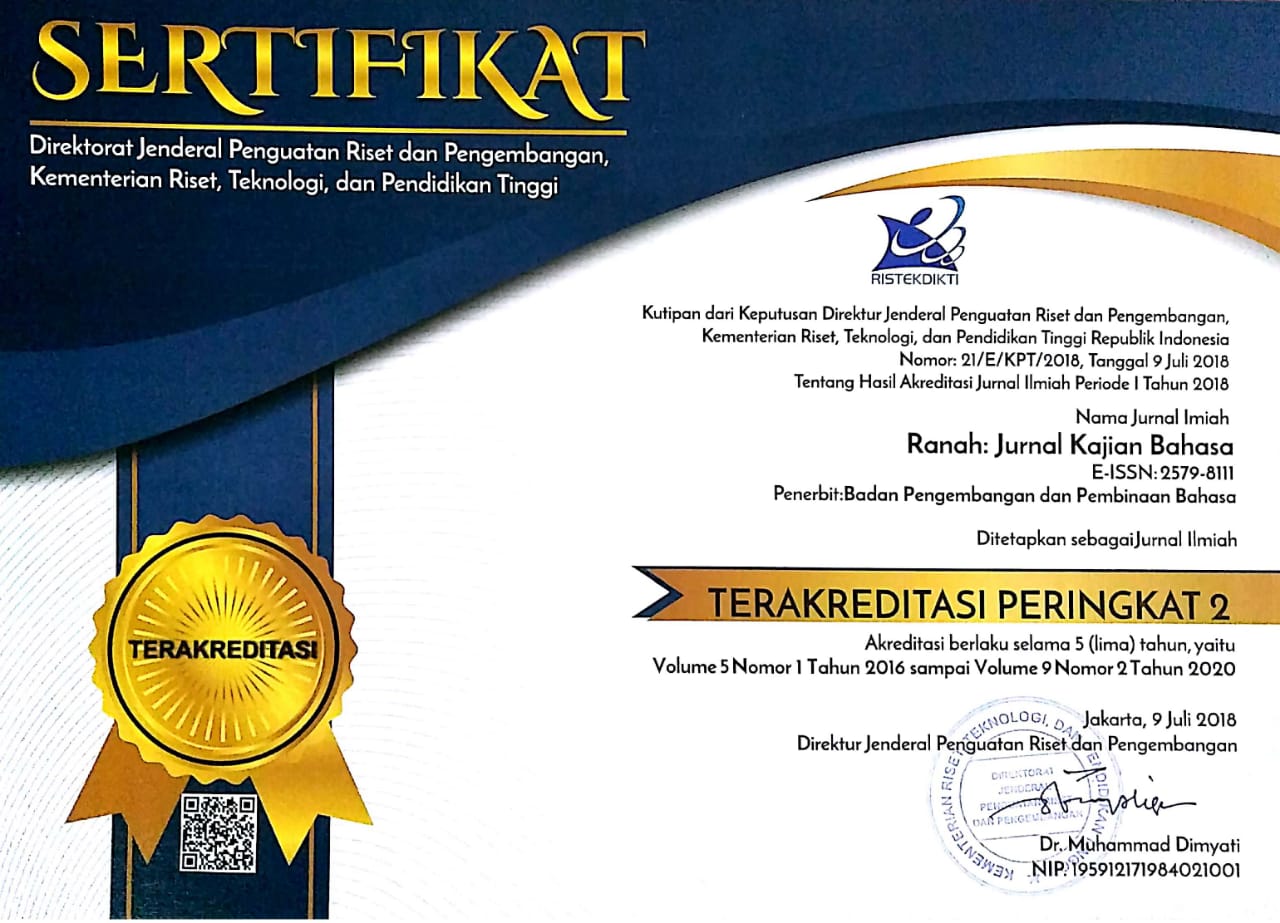Realisme Magis dalam Rondontō Karya Natsume Soseki
Abstract
It is said that magical realism first appeared in Germany in the 1920s. However, this also allegedly contained in Natsume Soseki’s Rondontō (published in 1905), way before the concept itself was being established. Rondontō tells about the visit of Japanese student to the Tower of London, where he experienced various irrational things. To prove Rondontō's values as a text with the genre of magical realism, we use five categorizations of magical realism by Wendy B. Faris. with literature review method. We categorize the magical realism characteristic in this text where irreducible elements were found in the form of the presence of spirits, then phenomenal world elements were fouind through the detailed descriptions and the appearance of unusual elements themselfs. In addition, there is also an element of unsettling doubt that is raised through the doubts of the main character in understanding his experience, which is connected to the merging of realms where the two worlds are joined between the fantasy stage and the real world. The main character keeps moving in time and places which indicates the occurrence of space and time disturbances. The presence of these five categorizations of magical realism indicates that Rondontō contains magical realism in it. Therefore, the statement that the concept of magical realism first appeared in Germany in the 1920s can not be said to be fit, but rather focuses only on its development in the west.
Abstrak
Realisme magis dikatakan muncul pertamakali di Jerman pada tahun 1920-an. Namun begitu, hal ini diduga terkandung pada teks Rondontō karya Natsume Soseki (1905), tahun dimana konsep ini belum dihadirkan. Rondontō bercerita tentang kunjungan mahasiswa Jepang ke Menara London, di mana ia mengalami hal-hal irasional. Untuk membuktikan bahwa cerpen Rondontō termasuk sebagai teks bergenre realisme magis, penulis menggunakan lima kategorisasi karakter genre realisme magis oleh Wendy B. Faris menggunakan metode studi pustaka, di mana unsur irreducible element digambarkan melalui hadirnya arwah masa lalu, lalu unsur phenomenal world melalui penggambaran detail yang amat rinci serta dimunculkannya elemen tidak biasa. Selain itu, terdapat unsur unsettling doubt yang dimunculkan melalui keraguan tokoh utama dalam memahami pengalamannya yang berkaitan dengan unsur merging realms (dua dunia tergabung antara panggung fantasi dan dunia nyata). Tokoh kerap melakukan perpindahan waktu dan tempat yang menandakan terjadinya unsur disruption of time and space. Kehadiran lima kategorisasi realisme magis ini menandakan bahwa cerpen Rondontō termasuk ke dalam teks bergenre realisme magis. Dengan demikian, pernyataan bahwa konsep realisme magis pertama kali muncul di Jerman pada tahun 1920an tidak dapat dikatakan sesuai, melainkan hanya berfokus pada perkembangannya di wilayah Barat.
Keywords
Full Text:
PDF (Bahasa Indonesia)References
Bowers, M. A. (2004). Magic(al) realism. Routledge.
https://doi.org/10.4324/9780203625002
Dwisusilo, S. M. (2008). Murakami Haruki no Shoki Sakuhin ni Tsuite. Bulletin of Graduate School of Humanities and Social Sciences, 17, 68-86. https://ci.nii.ac.jp/naid/120001124276/
_____. (2014). Orientalisme Jepang ala Takeda Rintaro: Wacana kesaman identitas dalam "Jawa Sarasa". Hikaku Bungaku: Journal of Comparative Literature, 57, 80-93.
_____. (2016). Takeda Rintaro dan Sanusi Pane : Dalam imaginasi budaya Asia. Bulletin of The Department of Teaching Japanese as a Second Language Hiroshima University, 26, 56-50.
Faris, W. B. (2004). Ordinary Enchantments: Magical realism and the remystification of narrative. Vanderbilt University Press.
https://doi.org/10.2307/j.ctv17vf68f
Firdausy, L. R. (2021). Hubungan Natsume Soseki dan Shakespeare: Kajian terhadap cerpen Rondontō (Skripsi, Universitas Airlangga). https://repository.unair.ac.id/105697/
_____. (2022). Ooka Shohei dan trauma pasca perang dalam Novel Nobi (Tesis, Universitas Airlangga).
Firdausy, L. R., & Susilo, S. M. D. (2022). The mobility of Natsume Soseki to London and his cultural adaptation in Rondontō. Leksema: Jurnal Bahasa dan Sastra, 7(1): 25-36. DOI: https://doi.org/10.22515/ljbs.v7i1.4837
Guenther, I. (1995). Magic Realism, New Objectivity, and the Arts during the Weimar Republic. Dalam L. P. Zamora & W. B. Faris (Eds.), Magical Realism: Theory, history, community. Duke University Press, 33-73.
https://doi.org/10.1215/9780822397212-003
Hisae, N. (2001). Soseki's study abroad and Hamlet. Liber Press
Homma, K. (2003). Natsume Soseki and his study of English literature. Doshisha Studies in Language and Culture, 5(4), 569-593.
Indarwanty, H., Budi, S. U., & Eka, S. V. (2015). Perbandingan extraordinary element dalam narasi fantasi, fiksi ilmiah, dan realisme magis. Jentera, 4(1), 48-55. DOI: https://doi.org/10.26499/jentera.v4i1.384
Kusumastuti, P. S. (2017). Analisis penggambaran unsur magis dalam Ponyo dan The Little Mermaid (kajian sastra bandingan) (Skripsi, Universitas Diponegoro Semarang).
Mestika, Z. (2004). Metode penelitian kepustakaan. Yayasan Obor Indonesia.
Mulia, S. W. (2016). Realisme magis dalam novel Simple Miracles Doa dan Arwah karya Ayu Utami. Jurnal Lakon, 5(1), 2016, 30-44. DOI: https://doi.org/10.20473/lakon.v5i1.2780
Ratna, N. K. (2004). Teori, metode, dan teknik penelitian sastra dari strukturalisme hingga poststrukturalisme perspektif wacana naratif. Pustaka Belajar.
Sholichah, I. (2020). Realisme magis Wendy B. Faris dalam novel "Maddah" karya Risa Saraswati. Bapala, 7(1).
Said, E. W. (1994). Orientalism. Vintage Books.
Soseki, N. (1905). 「倫敦塔」Rondonto. Tokyo: Shinchosha Publishing.
_____. (1997). The Tower of London: Tales of Victorian London. Peter Owen.
Warnes, C. (2009). Magical realism and the postcolonial novel. Palgrave Macmillan..
https://doi.org/10.1057/9780230234437
DOI: https://doi.org/10.26499/jentera.v12i1.4653
Refbacks
- There are currently no refbacks.






















